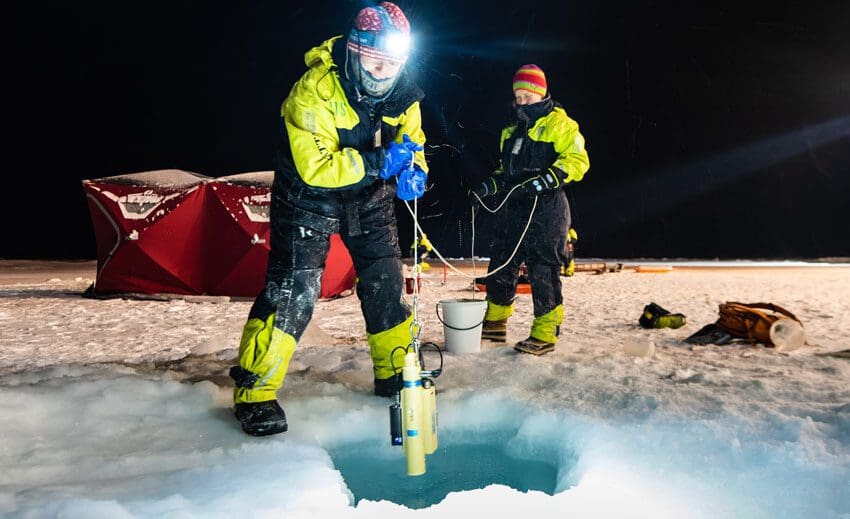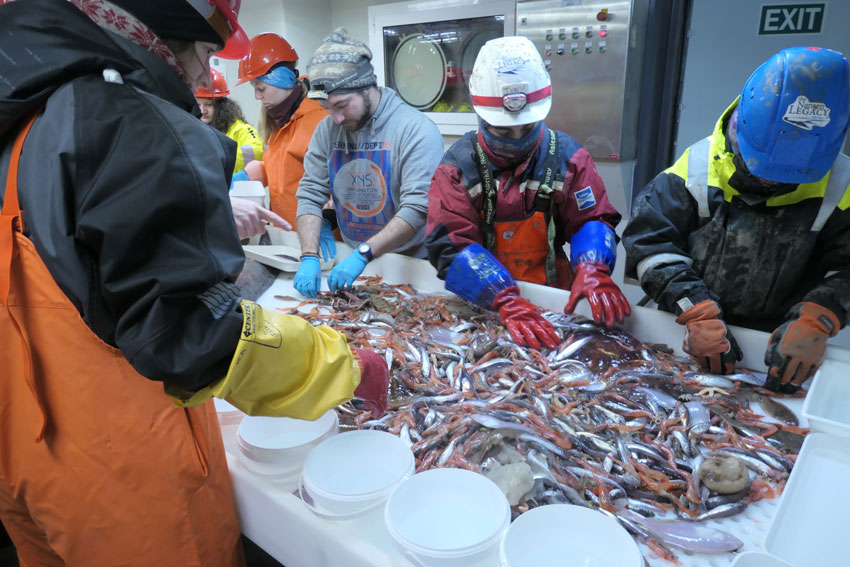World Oceans Day: The Nansen Legacy

UNIS PhD candidate Robynne Nowicki collects hydrographical data from the upper 10 m of the Arctic Ocean on the Nansen Legacy Q4 cruise in December 2019. Photo: Andreas Wolden/Institute of Marine Research
Top image: UNIS PhD candidate Robynne Nowicki collects hydrographical data from the upper 10 m of the Arctic Ocean on the Nansen Legacy Q4 cruise in December 2019. Photo: Andreas Wolden/Institute of Marine Research.
June 8 is World Oceans Day and in commemoration of this we focus on the Nansen Legacy project and UNIS activities within the project in 2019.
8 June 2020
Text by Associate Professor Janne E. Søreide and Professor Frank Nilsen, UNIS.
In 2019, UNIS participated in two major Nansen Legacy cruises in the polar night period. New information about life in the northern Barents Sea was obtained.
The Nansen Legacy is a large Norwegian research project with 10 participating institutions. More than 130 researchers are engaged in the project, of which more than half are young recruits enrolled in PhD or postdoc programmes. UNIS is strongly involved in the project and has in total six recruitment positions during this five-year long project. In addition, UNIS provide significant in-kind contributions with faculty staff and logistical support. The overall aim of the Nansen Legacy is to gain a more comprehensive understanding of the climate in the northern Barents Sea and how this in turn affects fisheries and the entire ecosystem.
Another important goal is to educate the next generation of Arctic scientists which is in line with the UNIS strategy. A total of 285 cruise days are funded through the project divided between physicists, biologists and technologists.
In the joint Nansen Legacy and A-TWAIN/SIOS-InfraNor oceanographic cruise in early November 2019, engineers and scientists from eight institutions steamed around Svalbard to service moorings, deploy a Seaglider, and make CTD profiles and transects with water samples. They successfully recovered and re-deployed the UNIS mooring between Edgeøya and Hopen that monitor possible Atlantic Water (AW) intrusion into the northern Barents Sea and the development of the sea ice cover in the region. Moreover, two new moorings were deployed east of Nordaustlandet to monitor inflow of AW from the north, between Nordaustlandet and Kvitøya.
RV Kronprins Haakon had just returned from this intensive cruise before the biologists re-loaded the vessel and turned it around again in late November. The main aim: to study the living Barents Sea during the polar night. The cruise was co-led by UNIS and The Arctic University of Norway. Winter cruises are rarely conducted in the high Arctic. It is challenging to do field operations in continuous darkness, combined with often unstable and stormy weather as well as freezing cold temperatures and sea ice formation.
The first storm hit RV Kronprins Haakon just a few hours after it left Longyearbyen. Fortunately, it got better when getting into the pack ice at around 81⁰N. Here the sea was frozen and thus calm. RV Kronprins Haakon has polar ice class and made good 4 to 6 knots on its way to our northernmost station at 82⁰N with ocean depths of 3600 metres. Almost no data from this time of year exists and all on board were therefore very excited. It was amazing to see all the buzzing life in the ocean. We had assumed most life to be in “hibernation”, but it was measurable amounts of algae, especially inside the sea ice, and zooplankton was abundant and very active. The large, fat and nutritious copepod Calanus hyperboreus produces up to 400 eggs. Copepod males were found in high numbers which in itself was very interesting since we rarely catch them. These males are very short-lived and are primarily present in winter. To make our way through the ice was fascinating. Several different types of ice were seen, and the frosty smoke was intense in the few open leads visible. On thin, newly formed ice beautiful frost flowers formed when the temperature dropped below minus 20C. These flowers can be up to 5 cm high and consist of fine, high-surface ice crystals that in turn gather many microorganisms. These flowers were carefully picked by the microbiologists and are currently being analysed.
Bacteria are much more abundant in sea ice than in the sea itself. Most sampling was conducted from the vessel, but the scientists also entered the sea ice to collect sea ice cores for physical and biological measurements. To be a polar bear guard and to watch sudden changes in the sea ice conditions is a challenge in the darkness, but strong ship lights and many people on watch made it safe to operate on the sea ice close to the ship. The cruise had an ambitious plan and most tasks were accomplished without any accidents. The largest challenge, however, was to sample the last and southernmost station of the Nansen Legacy transect in the Barents Sea. The strong wind and heavy swell made it impossible to sample benthos with the box corer or to deploy a drifting rig with sediment traps capturing everything that settles in the water column. The cruise ended in Tromsø 17 December.
Biological data from the polar night is of huge scientific interests since we have so limited knowledge from this time – a time period which may be one of the main bottlenecks for boreal species to establish themselves in the high Arctic.
More about the Nansen Legacy on https://arvenetternansen.com
